Nitrogen Fertilization Management with Blends of Controlled-Release and Conventional Urea Affects Common Bean Growth and Yield during Mild Winters in Brazil
Abstract
:1. Introduction
2. Materials and Methods
2.1. Field Site Description
2.2. Experimental Setup and Treatment Description
2.3. Quantification of Ammonia Volatilization
2.4. Analyses of Plant and Soil Samples
2.5. 15N-Fertilizer Recovery Analyses
2.6. Statistical Analyses
3. Results
3.1. Weather Conditions
3.2. Ammonia Volatilization
3.3. Mineral N Content in the Soil
3.4. Biomass (Dry Matter) Accumulation in Plants and Common Bean Yield
3.5. Nitrogen Uptake in Common Bean Plants
3.6. 15N-Fertilizer Recovery in Common Bean Plants
4. Discussion
5. Conclusions
Author Contributions
Funding
Acknowledgments
Conflicts of Interest
References
- CONAB. National Company of Supplying. Monthly Analysis of Common Bean; 2020. Available online: https://www.conab.gov.br/info-agro/analises-do-mercado-agropecuario-e-extrativista/analises-do-mercado/historico-mensal-de-feijao (accessed on 24 November 2020).
- Fageria, N.K.; Stone, L.F.; Santos, A.B.; Carvalho, M.C.S. Mineral Nutrition of Common Bean; EMBRAPA: Brasilia, Brazil, 2015; 394p. [Google Scholar]
- Zimmermann, M.J.; Rocha, M.; Yamada, T. Common Bean Crop: Factors that Affect Yield; Potafos: Piracicaba, Brazil, 1988; 589p. [Google Scholar]
- Reinprecht, Y.; Schram, S.; Marsolais, F.; Smith, T.H.; Hill, B.; Pauls, K.P. Effects of nitrogen application on nitrogen fixation in common bean production. Front. Plant Sci. 2020, 11, 1–19. [Google Scholar] [CrossRef] [PubMed]
- Carneiro, J.E.; Junior, T.J.P.; Borem, A. Common Bean from Sowing to Harvest; Federal University of Viçosa: Viçosa, Brazil, 2015; 384p. [Google Scholar]
- Rinaldi, L.F.; Garcia, P.L.; Sermarini, R.A.; Trivelin, P.C.O. 15N-Urea efficiency in maize as influenced by humic substances and urease inhibitors treatments. Commun. Soil Sci. Plant Anal. 2019, 50, 198–208. [Google Scholar] [CrossRef]
- Hong, N.; Scharf, P.C.; Davis, J.G.; Kitchen, N.R.; Sudduth, K.A. Economically optimal nitrogen rate reduces soil residual nitrate. J. Environ. Qual. 2007, 36, 354–362. [Google Scholar] [CrossRef] [PubMed] [Green Version]
- Dusenbury, M.P.; Engel, R.E.; Miller, P.R.; Lemke, R.L.; Wallander, R. Nitrous oxide emissions from a Northern Great Plains soil as influenced by nitrogen management and cropping system. J. Environ. Qual. 2008, 37, 542–550. [Google Scholar] [CrossRef] [PubMed]
- Kong, L. Maize residues, soil quality, and wheat growth in China: A review. Agron. Sustain. Dev. 2014, 34, 405–416. [Google Scholar] [CrossRef] [Green Version]
- Meira, F.A.; Sá, M.E.; Buzetti, S.; Arf, O. Doses and time of nitrogen top-dressed application for common bean in no-till system. Pesqui. Agropecuária Bras. 2005, 40, 383–388. [Google Scholar] [CrossRef] [Green Version]
- Henson, R.A.; Bliss, F.A. Effects of N fertilizer application timing on common bean production. Fertil. Res. 1991, 29, 133–138. [Google Scholar] [CrossRef]
- Araújo, A.P.; Teixeira, M.G. Relationshis between grain yield and accumulation of biomass, nitrogen and phosphorus in common bean cultivars. Rev. Bras. Ciência do Solo 2008, 32, 1977–1986. [Google Scholar] [CrossRef] [Green Version]
- Snyder, C.S. Enhanced nitrogen fertilizer technologies support the “4R” concept to optimize crop production and minimise environmental losses. Soil Res. 2017, 55, 463–472. [Google Scholar] [CrossRef]
- Tian, X.; Geng, J.; GUO, Y.; LI, C.; Zhang, M.; Chen, J. Controlled-release urea decreased ammonia volatilization and increased nitrogen use efficiency in cotton. J. Plant Nutr. Soil Sci. 2017, 180, 667–675. [Google Scholar] [CrossRef]
- Tian, X.; Li, C.; Zhang, M.; Li, T.; Lu, Y.; Liu, L. Controlled release urea improved crop yields and mitigated nitrate leaching under cotton-garlic intercropping system in a 4-year field trial. Soil Tillage Res. 2018, 175, 158–167. [Google Scholar] [CrossRef]
- Halvorson, A.D.; Del Grosso, S.J. Nitrogen source and placement effects on soil nitrous oxide emissions from no-till corn. J. Environ. Qual. 2012, 41, 1349–1360. [Google Scholar] [CrossRef] [PubMed]
- Grant, C.A.; Wu, R.; Selles, F.; Harker, K.N.; Clayton, G.W.; Bittman, S.; Zebarth, B.J.; Lupwayi, N.Z. Crop yield and nitrogen concentration with controlled release urea and split applications of nitrogen as compared to non-coated urea applied at seeding. Field Crops Res. 2012, 127, 170–180. [Google Scholar] [CrossRef]
- IPNI. Slow or Controlled Release and Stabilized Nitrogen Fertilizers. 2017. Available online: http://www.ipni.net/PUBLICATION/IA-BRASIL.NSF/0/90DE38570A7216CB832580FB0066E3B4/$FILE/Jornal-157.pdf (accessed on 24 November 2020).
- Garcia, P.L.; González-Villalba, H.A.; Sermarini, R.A.; Trivelin, P.C.O. Nitrogen use efficiency and nutrient partitioning in maize as affected by blends of controlled-release and conventional urea. Arch. Agron. Soil Sci. 2018, 64, 1944–1962. [Google Scholar] [CrossRef]
- Villalba, H.A.G. Blending Polymer-Sulfur Coated and NBPT-Treated Urea to Improve Nitrogen Use Efficiency and Grain Yield in Corn Production Systems. Ph.D. Thesis, University of São Paulo, Piracicaba, Brazil, 2018. Available online: https://www.teses.usp.br/teses/disponiveis/11/11140/tde-14082018-100857/pt-br.php (accessed on 24 November 2020).
- Guo, J.; Wang, Y.; Blaylock, A.D.; Chen, X. Mixture of controlled release and normal urea to optimize nitrogen management for high-yielding (>15 Mg ha−1) maize. Field Crops Res. 2017, 204, 23–30. [Google Scholar] [CrossRef]
- Garcia, P.L.; Sermarini, R.A.; Trivelin, P.C.O. Effects of nitrogen rates applying controlled-release and conventional urea blend in maize. J. Plant Nutr. 2019, 42, 2199–2208. [Google Scholar] [CrossRef]
- Garcia, P.L.; Sermarini, R.A.; Trivelin, P.C.O. Placement effect of controlled-release and conventional urea blend in maize. Commun. Soil Sci. Plant Anal. 2019, 50, 2321–2329. [Google Scholar] [CrossRef]
- Li, C.; Wang, Y.; Li, V.; Zhu, L.; Cao, Y.; Zhao, X.; Feng, G.; Gao, Q. Mixture of controlled-release and normal urea to improve nitrogen management for maize across contrasting soil types. Agron. J. 2020, 112, 3101–3113. [Google Scholar] [CrossRef]
- Li, C.L.; Cao, Y.Q.; Wang, Y.; Li, X.Y.; Li, Y.X.; Zhu, L.; Zhao, X.H.; Gao, Q. Effects of mixed controlled release and normal urea on maize (Zea Mays L.) growth, grain yield and nitrogen balance and use efficiency in northeast China. Appl. Ecol. Environ. Res. 2020, 18, 5367–5382. [Google Scholar] [CrossRef]
- Soil Survey Staff. Keys to Soil Taxonomy, 12nd ed.; USDA-NRCS: Washington, DC, USA, 2014. [Google Scholar]
- Gee, G.W.; Bauder, J.W. Particle-size analyzis. In Methods of Soil Analysis: Physical and Mineralogical Methods; Klaute, A., Ed.; ASA and SSSA: Madison, WI, USA, 1986; pp. 383–411. [Google Scholar]
- Bataglia, O.C.; Furlani, A.M.C.; Teixeira, J.P.F.; Furlani, P.R.; Gallo, J.R. Methods of Chemical Analysis of Plants; Instituto Agronômico: Campinas, Brazil, 1983; pp. 1–48. [Google Scholar]
- Van Raij, B.; Andrade, J.C.; Cantarella, H.; Quaggio, J.A. Chemical Analysis for Fertility Evaluation of Tropical Soils; Instituto Agronômico: Campinas, Brazil, 2001. [Google Scholar]
- Nelson, D.W.; Sommers, L.E. Total Carbon, organic carbon and organic matter. In Methods of Soil Analysis: Chemical Methods; Sparks, D.L., Ed.; ASA and SSSA: Madison, WI, USA, 1996; pp. 961–1010. [Google Scholar]
- Barrie, A.; Prosser, S.J. Automated analyses of light-element stable isotopes by isotope ratio mass spectrometry. In Mass Spectrometry of Soils; Boutton, T.W., Yamasaki, S., Eds.; Marcel Dekker: New York, NY, USA, 1996; pp. 1–46. [Google Scholar]
- Van Raij, B.; Cantarella, H. Corn for grain and silage. In Recommendation of Fertilization and Liming for the State of São Paulo; Cantarella, H., Quaggio, J.A., Furlani, A.M.C., Eds.; Instituto Agronômico: Campinas, Brazil, 1997; pp. 56–59. [Google Scholar]
- Mariano, E.; Filho, C.R.S.A.; Bortoletto-Santos, R.; Bendassoli, J.A.; Trivelin, P.C.O. Ammonia losses following surface application of enhanced-efficiency nitrogen fertilizers and urea. Atmos. Environ. 2019, 203, 242–251. [Google Scholar] [CrossRef]
- Fritsche, L.S. Urea-15N. Master’s Thesis, University of São Paulo, Piracicaba, Brazil, 2019. Available online: https://www.teses.usp.br/teses/disponiveis/64/64135/tde-09102019-091454/publico/Leticia_Sbrana_Fritsche_Revisada.pdf (accessed on 24 November 2020).
- Lisboa, F.C.; Silva, D.D.A.; Teixeira, I.R.; Silva, A.G.; Mota, J.H. Agronomic characteristics of common bean and castor bean hybrids in intercropping and monocropping. Rev. Bras. Eng. Agrícola Ambient. 2018, 22, 200–205. [Google Scholar] [CrossRef] [Green Version]
- Melo, L.C.; Peloso, M.J.D.; Pereira, H.S.; Faria, C.L.; Costa, J.G.C.; Diaz, J.L.C.; Rava, C.A.; Wendland, A.; Abreu, A.F.B. BRS Estilo—Common bean cultivar with Carioca grain, upright growth and high yield potential. Crop Breed. Appl. Biotechnol. 2010, 10, 377–379. [Google Scholar] [CrossRef] [Green Version]
- Reis, B.F.; Vieira, J.A.; Krug, F.J.; Giné, M.F. Development of a flow injections system two analytical paths for ammonium determination in soil extracts by conductometry. J. Braz. Chem. Soc. 1997, 8, 524–528. [Google Scholar] [CrossRef] [Green Version]
- Gonzaga, M.M.; Trivelin, P.C.O. Open Collector Efficiency to Capture NH3 Volatilized from the Soil. SIICUSP. 2018. Available online: https://uspdigital.usp.br/siicusp/siicPublicacao.jsp?codmnu=7210 (accessed on 24 November 2020).
- Embrapa. Knowing the Common Bean Phenology and Its Phytotechnician Aspects. 2018. Available online: https://ainfo.cnptia.embrapa.br/digital/bitstream/item/173690/1/CNPAF-2018-lvfeijoeiro.pdf (accessed on 24 November 2020).
- Laviola, B.G.; Martinez, H.E.P.; Souza, R.B.; Salomão, L.C.C.; Cruz, C.D. Macronutrient accumulation in coffee fruits at Brazilian Zona da Mata conditions. J. Plant Nutr. 2009, 32, 980–995. [Google Scholar] [CrossRef]
- Trivelin, P.C.O.; Lara Cabezas, W.A.R.; Victoria, R.L.; Reichardt, K. Evaluation of a 15N plot design for estimating plant recovery of fertilizer nitrogen applied to sugar cane. Sci. Agric. 1994, 51, 226–234. [Google Scholar] [CrossRef] [Green Version]
- Hauck, R.D.; Bremmer, J.M. Use of tracers for soil and fertilizer nitrogen research. Adv. Agron. 1976, 28, 219–266. [Google Scholar]
- R Development Core Team. R: A Language and Environment for Statistical Computing R. Foundation for Statistical Computing. 2015. Available online: http://www.R-project.org/ (accessed on 24 November 2020).
- Vanlauwe, B.; Chikowo, R.; Chekanai, V. Response of common bean (Phaseolus vulgaris L.) to nitrogen, phosphorus and rhizobia inoculation across variable soils in Zimbabwe. Agric. Ecosyst. Environ. 2018, 266, 167–173. [Google Scholar]
- Singh, S.P.; Terán, H.; Muñoz, C.G.; Osorno, J.M.; Tkegami, J.C.; Thung, M.D.T. Low soil fertility tolerance in landraces and improved common bean genotypes. Crop Sci. 2003, 43, 110–119. [Google Scholar] [CrossRef] [Green Version]
- Loss, A.; Pereira, M.G.; Costa, E.M.; Beutler, S.J. Carbon, nitrogen and the natural abundance of 13C and 15N in macro and microaggregates. Idesia 2014, 32, 15–21. [Google Scholar]
- Carvalho, M.C.S.; Nascente, A.S. Application of lime, phosphogypsum and fertilization rates affect soil fertility and common bean development in no-tillage system in a Cerrado Oxisol. Acta Sci. Agron. 2018, 40, e39322. [Google Scholar] [CrossRef]
- Ke, J.; Xing, X.; Li, G.; Ding, Y.; Dou, F.; Wang, S.; Liu, Z.; Tang, S.; Ding, C.; Chen, L. Effects of different controlled-release nitrogen fertilisers on ammonia volatilisation, nitrogen use efficiency and yield on blanket-seeding machine-transplanted rice. Field Crops Res. 2017, 205, 147–156. [Google Scholar] [CrossRef]
- Pires, R.C.M.; Arruda, F.B.; Fujiwara, M.; Sakai, E.; Bortoletto, N. Root-system depth of field bean and wheat under center pivot. Bragantia 1991, 50, 153–162. [Google Scholar] [CrossRef] [Green Version]
- Soratto, R.P.; Crusciol, C.A.C. Chemical soil attributes as affected by lime and phosphogypsum surface application in a recently established no-tillage system. Rev. Bras. Ciência do Solo 2008, 32, 675–688. [Google Scholar] [CrossRef] [Green Version]
- Vicensi, M.; Lopes, C.; Koszalka, V.; Umburanas, R.C.; Kawakami, J.; Pott, C.A.; Müller, M.M.L. Gypsum Rates and Splitting Under No-Till: Soil Fertility, Corn Performance, Accumulated Yield and Profits. J. Soil Sci. Plant Nutr. 2020, 20, 690–702. [Google Scholar] [CrossRef]
- Zhu, J.K. Plant Salt Stress. Encycl. Life Sci. 2007, 1–3. [Google Scholar] [CrossRef]
- Villalba, H.A.G. Blends of Polymer Coated Urea and Convetional Urea in Maize Fertilization. Master’s Thesis, University of São Paulo, Piracicaba, Brazil, 2014. Available online: https://www.teses.usp.br/teses/disponiveis/11/11140/tde-25022014-105031/pt-br.php (accessed on 24 November 2020).
- Lacerda, M.C.; Nascente, A.S.; Carvalho, M.C.S.; Mondo, V.H.V. Broadcast fertilizer rate impacts common bean grain yield in a no-tillage system. Afr. J. Agric. Res. 2015, 10, 1773–1779. [Google Scholar]
- Kluthscouski, J.; Stone, L.F. Efeitos nocivos do manejo inadequado da adubação no crescimento radicular das culturas anuais, com ênfase no potássio. Embrapa 2003, 158, 1–17. Available online: https://ainfo.cnptia.embrapa.br/digital/bitstream/CNPAF/21630/1/doc_158.pdf (accessed on 24 November 2020).
- Almeida, O.M.; Melo, H.C.; Portes, T.Q. Growth and yield of the common bean in response to combined application of nitrogen and paclobutrazol. Rev. Caatinga 2016, 29, 127–132. [Google Scholar] [CrossRef] [Green Version]
- Rabelo, A.C.R.; Ribeiro, D.F.; Rexende, R.M.; Alcantra, E.; Freitas, A.S. Nitrogen fertilization in the culture of bean. Revista Universidade Vale do Rio Verde. 2017. Available online: http://periodicos.unincor.br/index.php/revistaunincor/article/download/3141/pdf_671 (accessed on 24 November 2020).
- Qiao, N.; Xu, X.; Hu, Y.; Blagodatskaya, E.; Liu, E.; Schaefer, D.; Kuzyakov, Y. Carbon and nitrogen additions induce distinct priming effects along an organic-matter decay continuum. Sci. Rep. 2016, 6, 19865. [Google Scholar] [CrossRef]
- Wang, S.; Luo, S.; Yue, S.; Shen, Y.; Li, S. Fate of 15N fertilizer under different nitrogen split applications to plastic mulched maize in semiarid farmland. Nutr. Cycl. Agroecosyst. 2016, 105, 129–140. [Google Scholar] [CrossRef]
- Yi, Z.; Wang, P.; Hong, B.; Lu, L.; Yu, G. Effect of base N to dress N ratio on water and nitrogen utilization, growth of summer maize in North China Plain. II. Nitrogen accumulation and translocation of summer maize and dynamics of soil inorganic. N. Chin. J. Eco-Agric. 2008, 16, 86–90. [Google Scholar]
- Oliveira, R.A.; Buso, W.H.D.; Gomes, L.L.; Martins, P.H.M.; Rodovalho, R.S.; Oliveira, H.F.E. Application of controlled-release nitrogen fertilizer in irrigated common bean crops. Comun. Sci. 2019, 10, 158–167. [Google Scholar] [CrossRef]
- Schoninger, E.L.; Villalba, H.A.G.; Bendassolli, A.; Trivelin, P.C.O. Corn grain yield and 15N-fertilizer recovery as a function of urea sidedress timing. Anna. Braz. Acad. Sci. 2018, 90, 3299–3312. [Google Scholar] [CrossRef] [PubMed]
- Boschiero, B.N.; Mariano, E.; Torres-Dorante, L.O.; Sattolo, T.M.S.; Otto, R.; Garcia, P.L.; Dias, C.T.S.D.; Trivelin, P.C.O. Nitrogen fertilizer effects on sugarcane growth, nutritional status, and productivity in tropical acid soils. Nutr. Cycl. Agroecosyst. 2020, 117, 367–382. [Google Scholar] [CrossRef]
- Neptune, A.M.L.; Muraoka, T. Application of Urea-15N in Common Bean (Phaseolus vulgaris, L.) CV. Carioca. International Nuclear Information System. 1978. Available online: https://worldwidescience.org/topicpages/c/carioca+utilizando+15n.html (accessed on 24 November 2020).
- Kiehl, J.C.; Silveira, R.I.; Neto, J.B. Rates and methods of applying urea to common beans. Sci. Agric. 1993, 50, 254–260. [Google Scholar] [CrossRef]
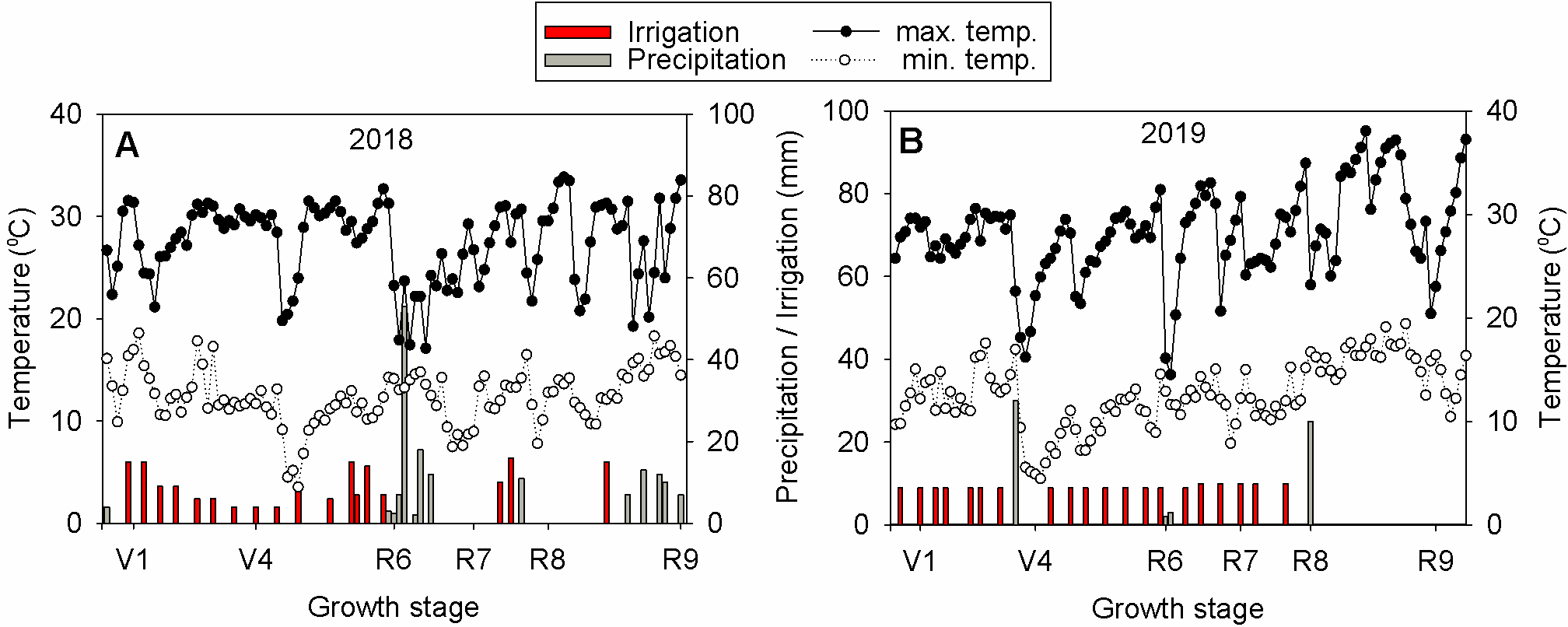
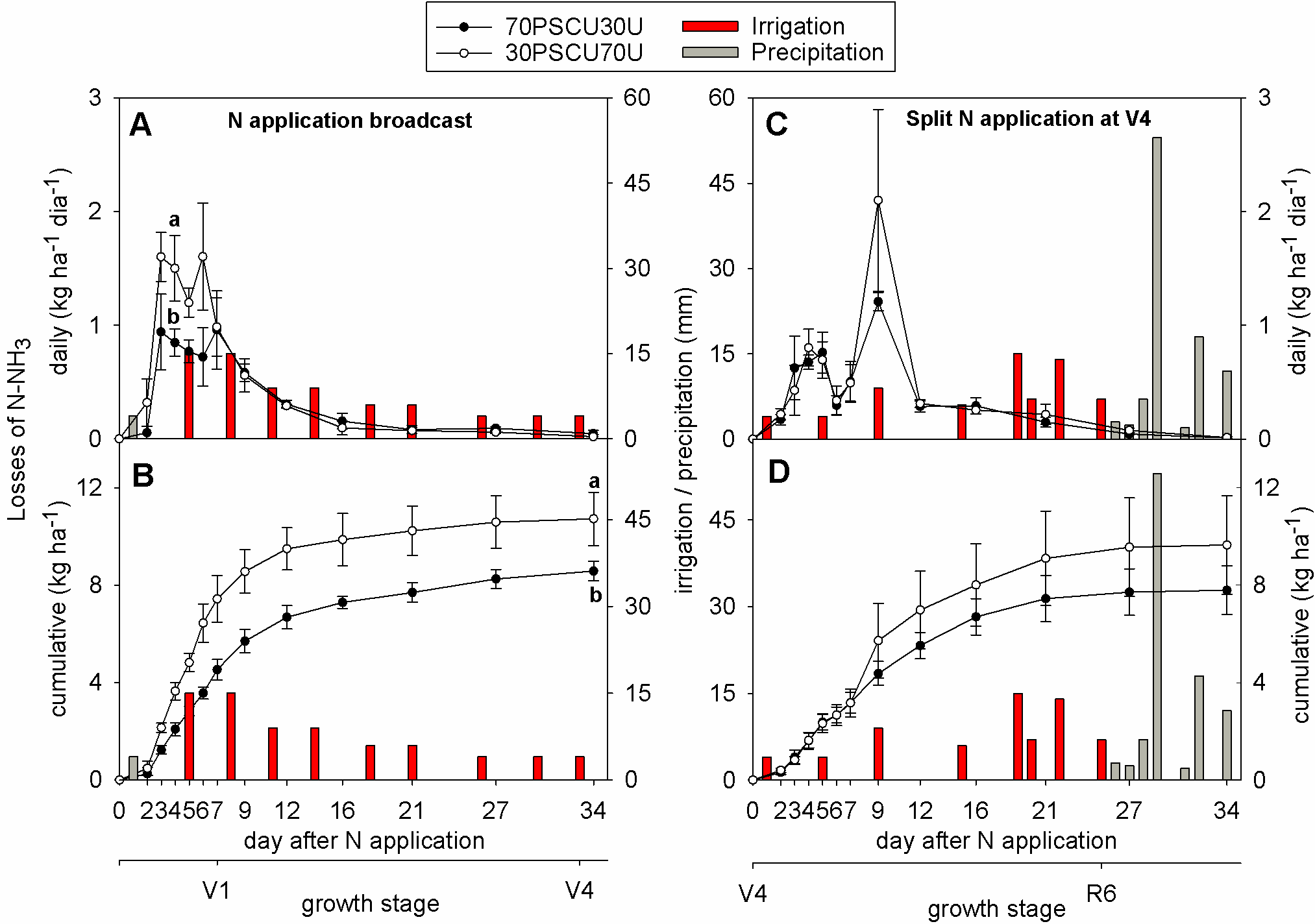
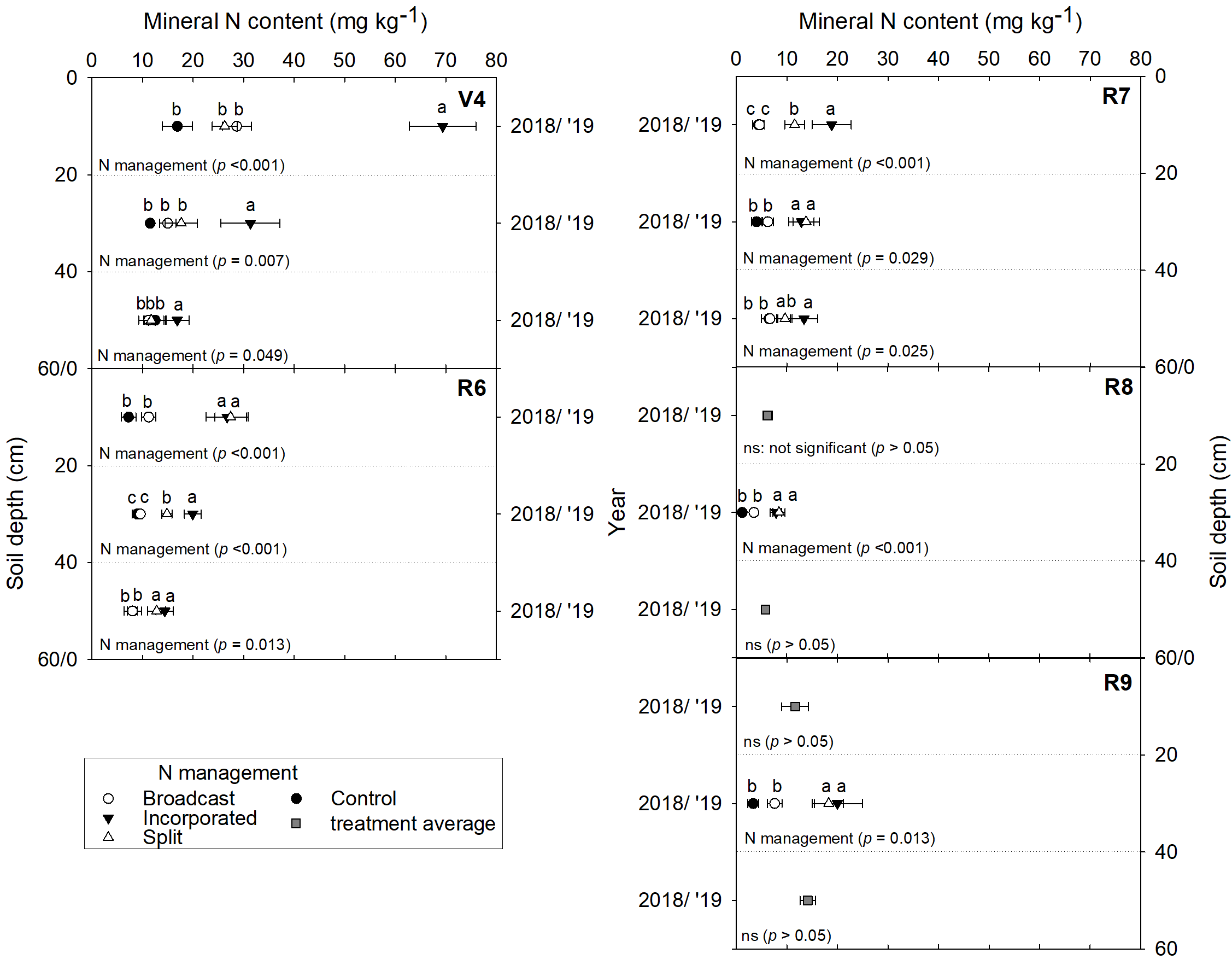

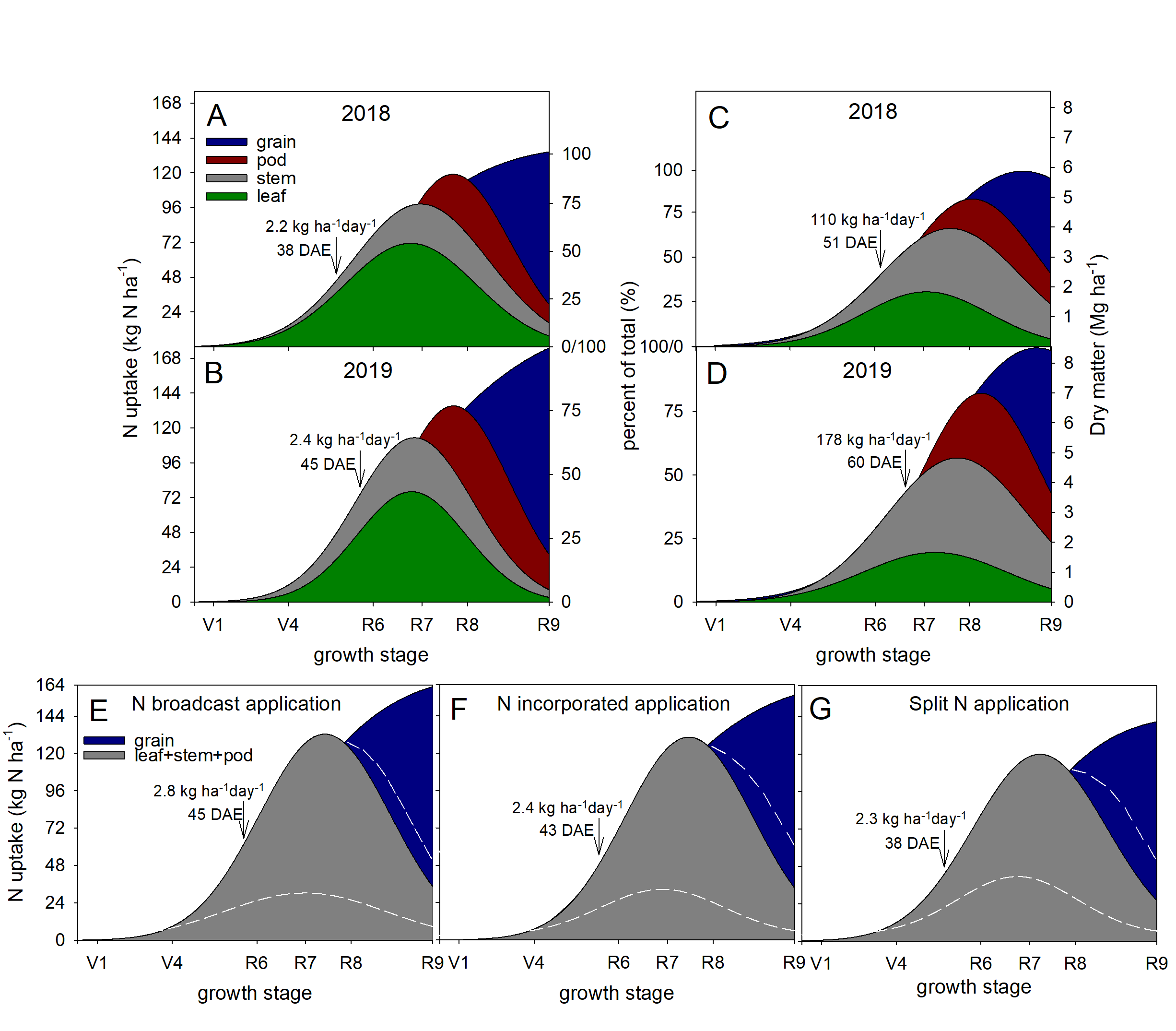
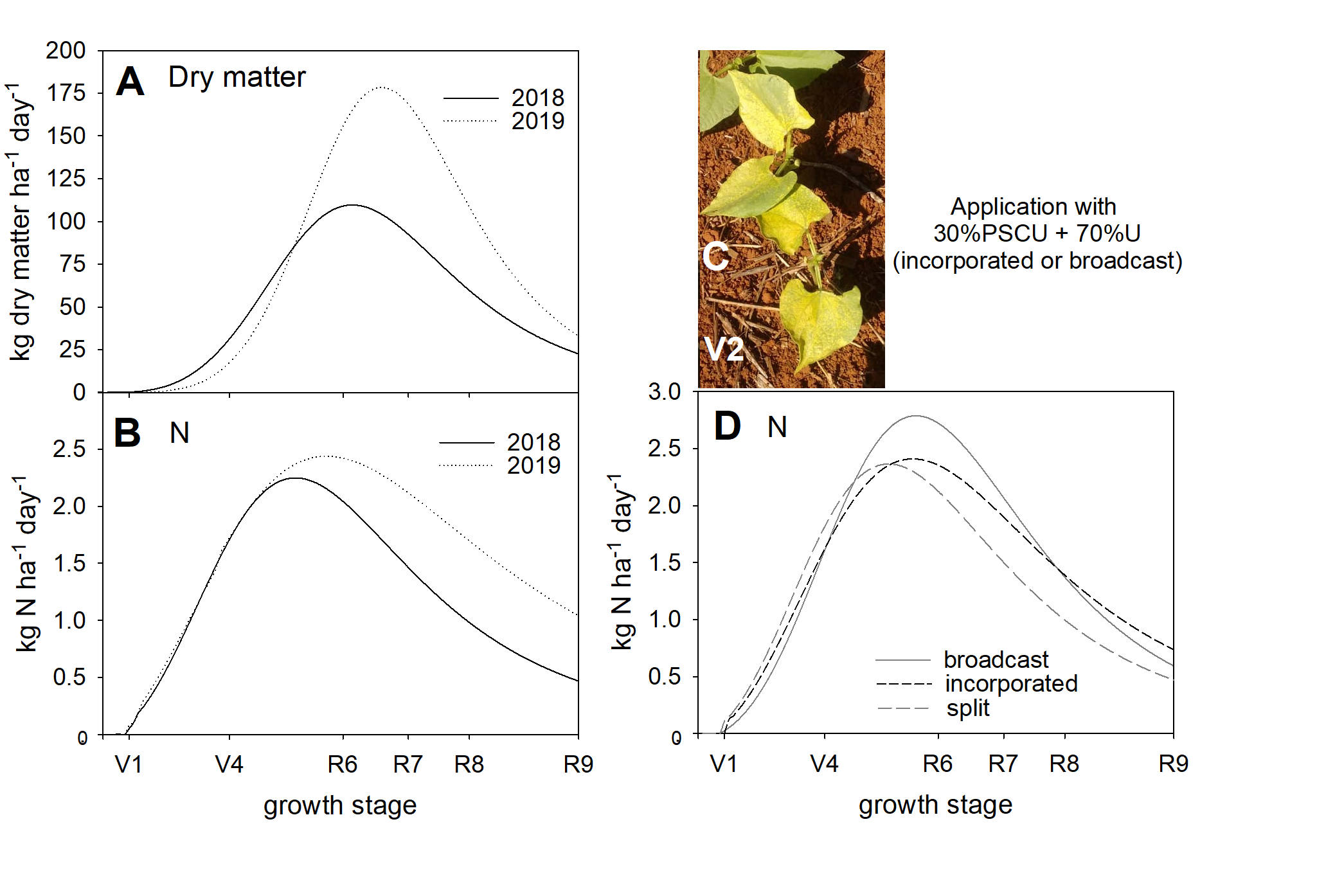



| Depth | pH | SOM 1 | TSN 2 | NH4+ | NO3− | S | P | K | Ca | Mg | Al | CEC 3 | AlS 4 | BS 5 |
|---|---|---|---|---|---|---|---|---|---|---|---|---|---|---|
| cm | g dm−3 | mg kg−1 | mg dm−3 | mmolc dm−3 | % | |||||||||
| 2018 | ||||||||||||||
| 0-20 | 5.0 | 27 | 1130 | 1.1 | 2.4 | 30 | 64 | 2.4 | 29 | 7 | 2 | 58.4 | 5 | 66 |
| 20-40 | 4.2 | 22 | 883 | 3.4 | 3.1 | 183 | 13 | 1.3 | 12 | 3 | 14 | 36.3 | 46 | 45 |
| 40-60 | 4.2 | 20 | 820 | 1.3 | 2.9 | 207 | 13 | 1.3 | 12 | 3 | 12 | 38.3 | 42 | 43 |
| 2019 | ||||||||||||||
| 0-20 | 5.1 | 27 | 1300 | 7 | 9 | 26 | 46 | 5.3 | 29 | 12 | 0 | 84 | 0 | 55 |
| 20-40 | 4.5 | 16 | 1000 | 9.6 | 5.2 | 67 | 10 | 3.5 | 19 | 8 | 0 | 83 | 0 | 37 |
| 40-60 | 4.4 | 14 | 800 | 3.2 | 4.7 | 135 | 5 | 2.7 | 12 | 6 | 2 | 79 | 9 | 26 |
Publisher’s Note: MDPI stays neutral with regard to jurisdictional claims in published maps and institutional affiliations. |
© 2020 by the authors. Licensee MDPI, Basel, Switzerland. This article is an open access article distributed under the terms and conditions of the Creative Commons Attribution (CC BY) license (http://creativecommons.org/licenses/by/4.0/).
Share and Cite
Garcia, P.L.; Sermarini, R.A.; Trivelin, P.C.O. Nitrogen Fertilization Management with Blends of Controlled-Release and Conventional Urea Affects Common Bean Growth and Yield during Mild Winters in Brazil. Agronomy 2020, 10, 1935. https://doi.org/10.3390/agronomy10121935
Garcia PL, Sermarini RA, Trivelin PCO. Nitrogen Fertilization Management with Blends of Controlled-Release and Conventional Urea Affects Common Bean Growth and Yield during Mild Winters in Brazil. Agronomy. 2020; 10(12):1935. https://doi.org/10.3390/agronomy10121935
Chicago/Turabian StyleGarcia, Pedro Lopes, Renata Alcarde Sermarini, and Paulo Cesar Ocheuze Trivelin. 2020. "Nitrogen Fertilization Management with Blends of Controlled-Release and Conventional Urea Affects Common Bean Growth and Yield during Mild Winters in Brazil" Agronomy 10, no. 12: 1935. https://doi.org/10.3390/agronomy10121935
APA StyleGarcia, P. L., Sermarini, R. A., & Trivelin, P. C. O. (2020). Nitrogen Fertilization Management with Blends of Controlled-Release and Conventional Urea Affects Common Bean Growth and Yield during Mild Winters in Brazil. Agronomy, 10(12), 1935. https://doi.org/10.3390/agronomy10121935






